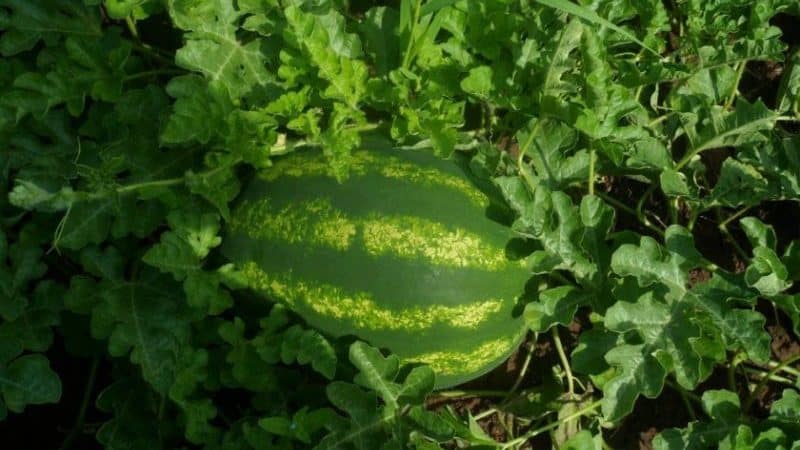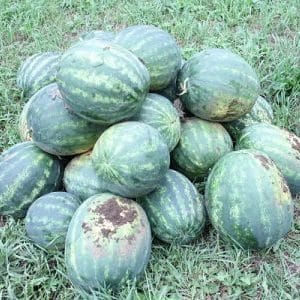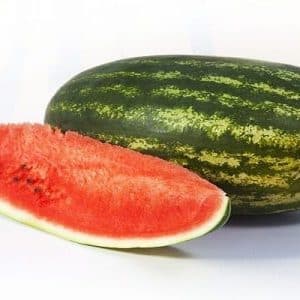Early ripe hybrid watermelon "Ataman" with giant fruits and unique taste
Early ripening watermelon Ataman is grown in the middle zone and in the south of our country. The hybrid is resistant to diseases and shows stable yields every year. It is planted in open ground, having previously prepared the seedlings.
In the article we will look in detail at what the Ataman watermelon is and how to get a rich and tasty harvest on your site.
Description of watermelon
Ataman ripens in 45–55 days from the moment the first shoots appear. The bush is powerful, the leaves are large. From four to six ovaries are formed simultaneously on one plant.
Distinctive features
The hybrid does not require special knowledge and skills to care for and is immune to weeds and insect pests. The ataman produces fruits in unison; his fruiting period is extended.

Composition, properties, benefits, calorie content
The pulp contains vitamins A, E, C and microelements. Watermelon is famous for its diuretic effect, removing waste and toxins from the body. 100 g of watermelon contains 25 kcal, 90% of it consists of water.
The berry has a beneficial effect on metabolic processes, improves digestion, and relieves bloating and inflammation of the intestines. Watermelon is rich in ascorbic acid and niacin, which strengthen the immune system and protect the human body from premature aging.
Fruit characteristics and yield
The fruits are oval-round, dark green with light stripes. The peel is elastic and dense, glossy. The weight of the fetus is 4-14 kg.The pulp is rich in fiber, bright red, juicy and sweet. Productivity is about 5 kg per 1 sq. m.
Seeds of watermelon
The seeds are small, brown in color. The surface is smooth, with small spots. The seeds are not eaten.
How to grow your own
Hybrid Ataman is grown by seedlings. This will help protect the crop from pests and diseases and increase productivity.
Planting and growing seedlings
Ataman hybrid seeds are purchased from trusted producers. When purchasing, pay attention to the expiration date and integrity of the packaging.. The seeds are checked for germination - placed in a saline solution for 15 minutes and stirred clockwise. The seeds that sink to the bottom are used for planting.
Afterwards, the material is disinfected using Bordeaux mixture or the drug “Fitosporin-M”. The procedure improves seed germination and increases yield.
For growing seedlings, prepare a convenient container. They use flower pots, plastic cups, and cassettes with pallets. The container is washed with soda solution and wiped dry with a clean towel. For watermelon, light nutritious soil from the garden or ready-made soil from the store is suitable. It is recommended to disinfect the soil with a weak solution of potassium permanganate before planting.
Soil is poured into the container and grooves are made at a distance of 7–10 cm from each other. Warm water is poured into each and two seeds are placed. Sprinkle earth on top and slam down. The hybrid is watered once every 5 days, and two weeks after planting, liquid organic fertilizers are added - manure, chicken droppings, humus.
Store containers on a sunny windowsill - for healthy development, watermelon requires a lot of light and heat.
Vegetable garden planting and care
Before planting, prepare the beds.Melons love a mixture of sandy and loamy soils with neutral acidity. It is recommended to dig up the soil at the end of October, before the first snow. To fertilize it, manure is added - over the winter it will saturate the soil with nutrients.
The soil is dug up again in March, removing weeds and debris. If the soil is acidic, then liming is carried out before planting - sprinkle with a mixture of dry lime and wood ash.
Important! Holes are prepared in the beds, each about 8 cm deep. For planting, choose a cloudy, windless morning. A seedling is placed in each hole and the base of the stem is sprinkled with soil. It is recommended to use mulch - a mixture of sawdust, leaves and grass. It nourishes the roots and retains moisture in the soil.
Care includes regular watering and fertilizing. Water the plant once every 3-4 days, about 2 liters are spent on one bush. In addition to moistening the roots, spraying from a spray bottle is required - they accelerate the development of fruits. Use clean water at room temperature - cold water can provoke the appearance of fungi and viruses.
The watermelon is fed with organic and mineral fertilizers - manure, ash, yeast, grass infusion, potassium salt, ammonium nitrate, superphosphate. During the growing period, fertilizers are applied 3-4 times with an interval of 10 days. Fertilizing strengthens roots and stems, protects them from insect pests, and improves the marketability and taste of fruits.
Features of cultivation and possible difficulties
When growing watermelon in a greenhouse, a number of rules are followed. Indoor soils are characterized by high humidity, so water the plant twice a week. If the summer is rainy and hot, then once. Every day the greenhouse is ventilated using vents, doors and windows are opened.
When the ovaries form fruits, the plant is tied to a support so that the stem does not break. In a greenhouse, the hybrid is grown in one stem, the top is pinched and the side shoots are removed.
In open ground, after planting seedlings, the plant is covered with thin glass or polyethylene. This protects young bushes from possible frosts, winds and rains. The protection is removed after a week.
To increase productivity, monitor the amount of fertilizer applied. If the leaves become thin, this is a sign of an excess of nitrogen. The appearance of ulcers signals an excess of phosphorus. To solve the problem, the beds are watered abundantly and sprinkled with dry wood ash.
Diseases and pests
Diseases and pests appear due to improper care, heat or humidity, and dense planting. In watermelon beds there are:
- Olive spot. Occurs due to weeds and plant debris, contaminated soil. The fungus can develop in open ground and in greenhouse conditions. Brown spots appear on the leaves and fruits, and within 8-12 days the disease covers the entire plant. For the prevention and treatment of olive spot, the drug “Quadris” is used.
- Bacteriosis (angular spot) develops due to insects that carry dangerous microbes throughout the garden. Infected plants have light spots on the leaves, then they become holey and soon the bushes die. For prevention, spraying with whey and iodine is used, for treatment - a solution of copper sulfate or Bordeaux mixture.
- melon aphid - a small insect that lives on the inside of the leaf. It feeds on the sap of the plant, and over time a dark coating forms on the bushes. For prevention, it is recommended to plant garlic, onions, and herbs next to the watermelon.For treatment, the drugs “Commander” or “Karate” are used.
- Sprout fly It is dangerous because its larvae hide inside the stem and destroy it. To prevent its occurrence, loosening and weeding of beds and disinfection of seeds are used. For treatment, Iskra or Karbofos are used.
Harvesting and application

Harvest in August, when the fruits become glossy and elastic. The berries are removed along with the stalk, wiped with a dry cloth and laid out on the beds for several hours. Thanks to their thick rind, watermelons can be stored for up to a month without losing their taste and beneficial qualities.
Due to their low calorie content and vitamin composition, they are used to prepare dietary dishes - fruit salads, cocktails, juices.
Interesting. Hybrid Ataman is great for winter preparations. Sweets are made from watermelon rinds and lemon jam, prepared from pulp compote. Watermelon can also be found in recipes for preparing nutritious snacks. Its sweet taste goes well with cheese, ham, olives and shrimp.
Advantages and disadvantages
The Ataman hybrid has no significant disadvantages. However, watermelon is only suitable for growing in warm, temperate regions. At the same time, it has a number of advantages:
- sweet sugary pulp;
- resistance to diseases and pests;
- ease of care;
- versatility of use;
- stable yield;
- good keeping quality.
Conclusion
The early ripening watermelon Ataman is suitable for cultivation in the middle zone and in the south of the country. To grow the Ataman f1 hybrid, seedlings are prepared by first disinfecting the seeds. The seedlings are regularly watered with warm water and fertilized with liquid organic matter. Planted on sunny and light soils, cleared of debris.
Watermelon ripens in 50 days and is distinguished by large fruits and tasty pulp. The ripeness of the crop is determined by its glossy skin and sweet aroma. Ataman is used fresh to prepare sweet desserts and healthy dietary dishes.